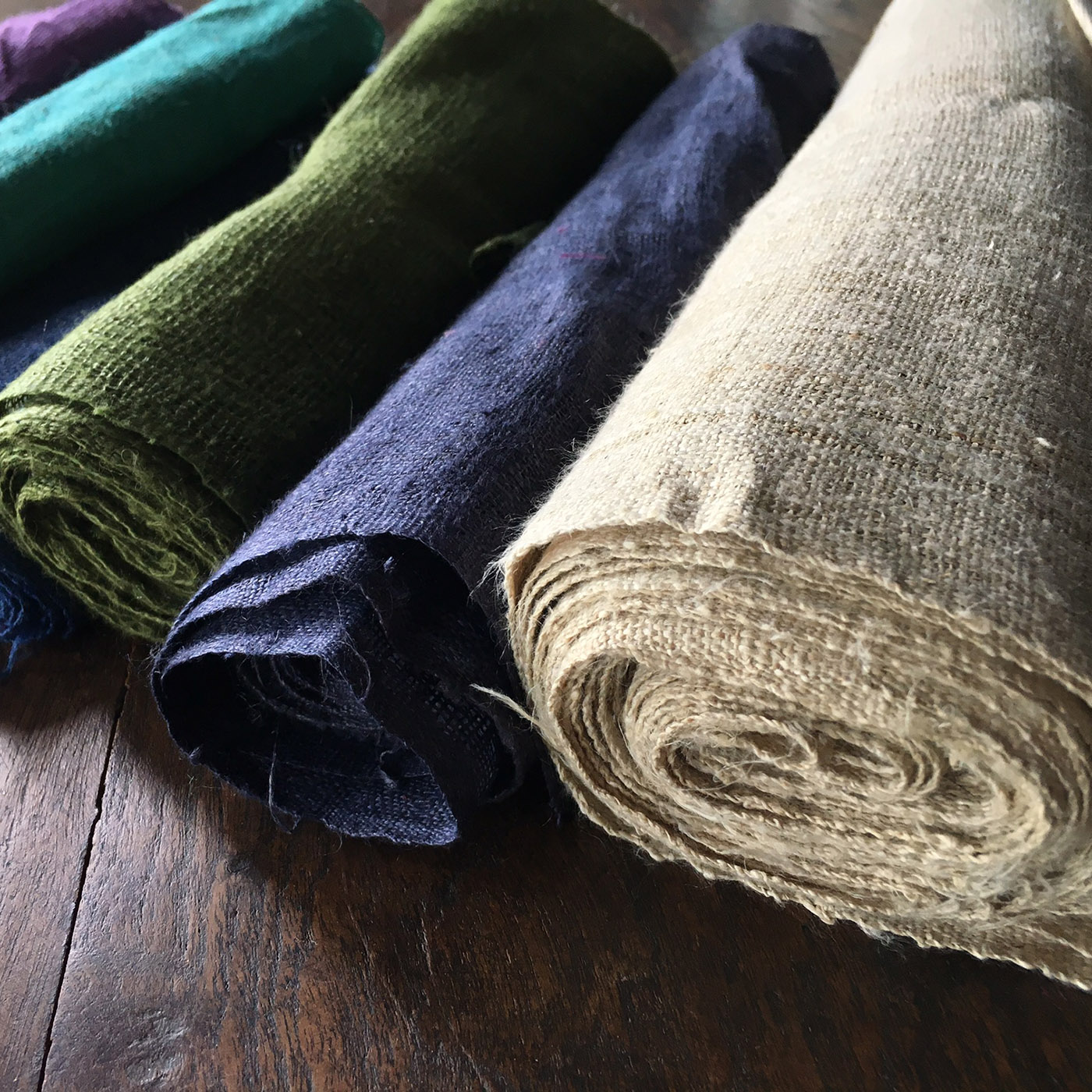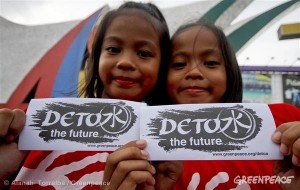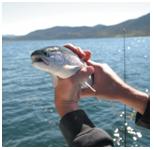Is hemp a more sustainable textile fibre than cotton?
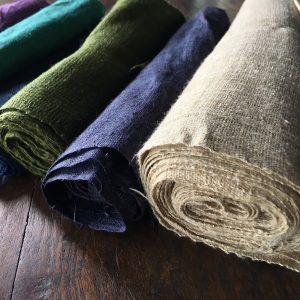
Hemp is an environmentally friendly and sustainable alternative for textiles. There are many promotional and interesting stories about hemp on the various blogs and eco fashion website1. One source claims that hemp is superior to cotton in all aspects and “a major game changer for our world“2. Social entrepreneurs are watching closely the emergence of industrial hemp as alternative, more sustainable fibre source. By searching for hemp in google, the reader will easily find dozens of websites promoting the use of hemp for textiles. But is this realistic?
Advantages of hemp fibers
Hemp fans claim a variety of advantages: hemp fibers are antibacterial, durable and resilient, and work as a natural air-conditioning system. Hemp is a fast-growing plant that consumes significantly less water than cotton and does not require herbicides, pesticides, synthetic fertilizers or GMO seeds.
The market of fibre crops
One keeps wondering why not all the market has already converted to using hemp. However, the reality is very different: hemp is almost negligible and has only 0.2% share of fibre crops: 100 tons of hemp vs. 23.500 tons of cotton3.

Why is hemp so small
So, why is hemp so small? A key reason is the connection of the plant, Cannabis Sativa, with drugs, and therefore cultivation has been severely hampered. In the western world the industrial use of the cannabis plant is prohibited. Apart from the drug issue, there were also vested business interests involved in the history how hemp became illegal4. The situation is different in China which currently accounts for more than 50 percent of the global hemp production and holds a large share of patents on hemp fibers and textile production.
Hemp has been used for textiles since thousands of years. The controversy stems from the fact that the hemp plant, whose horticultural name is “Cannabis sativa” comes in several varieties, one of which is the source of marijuana.
The dispute is about whether industrial hemp, the fiber plant, should be allowed to be grown, while at the same time the hallucinogenic plant, the source of marijuana, is legally banned in many countries in the Western world. Hemp still faces a negative reputation due to its association with psychoactive cannabis and the war on drugs. While industrial hemp returned to the United States on limited terms in 2014, it is allowed to grow in Canada since 1998, though the plant remains more restricted than other crops5. Today, about 100,000 acres of hemp are grown annually in Canada.
Hemp that contains less than 0.3% of an ingredient called Tetrahydrocannabinol (THC) is considered non-remedial hemp. Hemp that contains more than 0.3% of THC is considered remedial hemp – marijuana, in which the THC content is significantly higher, up to 22%.
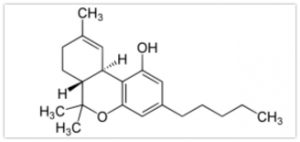
Why cotton is far more popular
Apart from the undoubted environmental aspects, the are technical reasons, some differences in applicability and performance which is often overlooked or not understood by the various promoting channels.
In terms of processing, according to a scientific paper6, there are „some key problems encountered in the processing of bast fibers from hemp for the production of textiles. These problems include the high content of pectin, the excessive rigidity and the poor “spinnability” of hemp fibers“
Chemically, hemp is related to cotton. Both are made of cellulose. However, hemp requires dramatically less water and irrigation than cotton. 20.000 L water for 1 kg of cotton compared to 300-500 L water for 1 kg of hemp7.
The cellulose content of hemp is less than in cotton: 70% in hemp vs. >90% in cotton. Also, hemp´s lignin content is much higher. The main challenge in preparing hemp fibers for textile applications is to remove the non-cellulosic substances without damage to the fiber cellulose8.
Hemp processing involves processes to remove pectine and lignin, a hard, woody biopolymer that makes up 8-10% of the dry weight, and is responsible for the rough, scratchy feel.
Retting, the prices for removal of pectine, may involve the use of chemicals such as caustic soda, soda ash, enzymes or mineral acids.
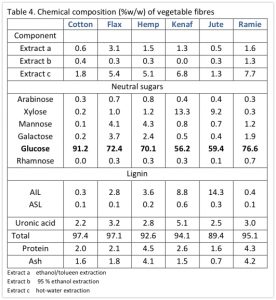
If the lignin is removed, the resulting fibre is much smoother and softer. The inability to remove lignin from hemp without reducing its strength was another reason why the usage of hemp declined dramatically in the post-industrial period. Today lignin can be removed by enzymatic processes.
A characteristic feature of hemp is it’s abrasive nature; it does not feel as soft as cotton. Garments made entirely from hemp tend to wrinkle easily, because, like linen, it’s elastic recovery is very poor.
Another issue is colouration. Cotton can be dyed, mostly with synthetic dyes, to achieve a desired color and to meet the demand of the fashion industry. In contrast to cotton which is almost white or greige, hemp’s appearance can be naturally creamy white, green, brown, grey and even black. However, the downside is the more tedious procedures, if at all possible, to achieve brilliant shades demanded by the fashion industry which limits hemp to rather dull colors and technical textiles.
Technically, hemp can be dyed as cotton. However, to be considered a fully eco product, hemp should be dyed with natural dyes, not using any synthetic dyes. On the other hand, natural dyes are far more expensive and inferior in performance compared to synthetic dyes.
Hemp is also not as soft as cotton, its harsh appearance is a limitation for the buyer. Therefore, hemp can never fully replace cotton.
Outlook
It is unrealistic to expect that hemp would capture significant market shares from cotton. Nevertheless, despite its limitations, hemp is becoming more and more popular in the eco fashion market as certain designers see the potential as an environmentally sound alternative fibre. It is justified from the environmental point of view and will occupy an interestingly attractive niche market.
References:
- for example: fashionunited.com
- Martina, J. , „HEMP VS COTTON: THE ULTIMATE SHOWDOWN“ (2013)
- van Dam, J.E.G., „Markets for fibre crops in EU and China“, Food and Biobased Research Wageningen (2014)
- Martino,J., „HOW HEMP BECAME ILLEGAL: THE MARIJUANA LINK“ (2012)
- O’Connell,K., What the United States can learn from Hemp Legalization in Canada (2017)
- Zhang JinqiuZhang Jianchun „Effect of Refined Processing on the Physical and Chemical Properties of Hemp Bast Fibers“, Textile Research Journal , 80/8(2009), 744 – 753
- zambeza.de: WIE SCHLÄGT SICH NUTZHANF ALS ÖKO-PFLANZE IM VERGLEICH ZU BAUMWOLLE
- Wang, H.M., Postle, R., Kessler, R.W., Kessler, W., „Removing Pectin and Lignin During Chemical Processing of Hemp for Textile Applications“, Textile Research Journal, 73/8 (2003), 664 – 669
- sensiseeds.com: How Hemp Textiles Are Produced

